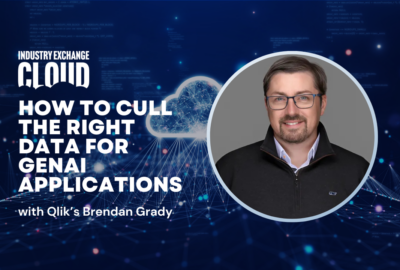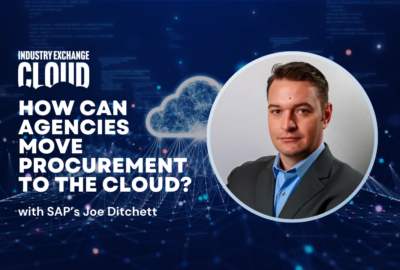Insight by Leidos
Cloud Exchange 2022: Leidos’ Kass Singh on reducing burdens, driving transformation in healthcare
Service integration can help agencies understand if cloud services will improve healthcare delivery, says Leidos’ Kass Singh. We sit down with her during the ...
Yes, there is no doubt moving systems and applications to the cloud will address some of those goals.
The real goal for many healthcare agencies and organizations is to reduce the operational and maintenance burden on the staff and patients.
Kass Singh, vice president and solution architect in the Leidos Health Group, said relieving that burden will let employees focus on the transformation instead of the sustainment of legacy systems.
“We’re certainly seeing a very large move into the adoption of cloud in various ways. That move to cloud is often borne by the need to reduce costs but also the burden on the health staff, whether it be the nurses, the doctors or the staff more generally,” Singh said during the Federal News Network Cloud Exchange 2022.
In some examples, a lift and shift to the cloud makes sense, especially if legacy applications are entrenched in the business processes and workflow, she said. “It’s about how do you surround that legacy application that you’ve lifted and shifted with more modern technology to enhance the user experience or the employee experience in a composable way that doesn’t cause other challenges.”
Singh said Leidos has worked on several projects, internally and externally, where it sought to lower the burden on employees and customers alike.
Start by asking simple questions
The first such project was a healthcare client that initially wanted to use the cloud to reduce hardware and software costs over a five-year period.
“We started by looking at the ecosystem of their software as well as their infrastructure, and joined them together to put that strategy together in terms of what they were ready for. There were some instances where cloud wasn’t the answer. But there were ways we could help them accelerate the benefits of using a shared service that comes with cloud and also the ability to burst during peak periods,” Singh said.
Initially, there is often a belief that moving to the cloud is an all-in proposition. “A big part of what we do is ask, ‘What are you ready for? What’s the right migration path strategy for you?’ ” she said. “For this particular customer, that was looking at their data costs and especially when they were exchanging with so many different products. And they had a number of service providers as well.”
The analysis helped the agency reduce its data management costs and the overall cost of technology.
Plan out possible service integration
Singh recounted another typical use case that involved automation to improve how a healthcare organization responded to patient needs. The cloud and automation strategy sought to address workflow challenges to give employees more time to work with each patient.
“When you had to call a doctor during COVID, you couldn’t go into the office so you needed a virtual telehealth solution. All these products have it. But there wasn’t a product that let you book a single appointment, multiple appointments,” she said. “And all the information about you, as a patient, had to be available at the right step of the process, regardless of whether it was a nurse, a caseworker. Whoever it was needed to see the right information at the right time,” she said. “That required a combination of new software as well as moving some of the legacy systems in various cloud migration paths to a different platform.”
In this scenario, the cloud could provide needed service integration, Singh said. This requires agencies to analyze their entire technology portfolios and how they’re configured to determine the best tools to perform specific functions.
“It’s about optimizing the investments you’ve already made on top of any additional scripts or products you may need to insert to make that process as smooth as possible,” she explained. “Because what you don’t want to do is create so much custom software or create a different problem trying to resolve that. There’s a fine art and balance of kind of bringing that all together.”
Service integration also makes the use of application programming interfaces more critical because agencies have to connect disparate systems that could reside on premise or in the cloud. Many organizations end up needing to develop a data platform to handle API integration needs.
“Data exchange and interoperability is definitely a big challenge in health ecosystems,” she said. “What I’m seeing is a big shift to create composable software, especially if looking at enhancing the digital experience. Do I need a full application, or is really what I’m after a lightweight user interface? But maybe all I really want is a digital experience interface that’s not tightly integrating the back end to give me the enhancements I need. That way I can get immediate direct feedback from the users of that system, and then I can go at a different pace behind the scenes as well.”
Data strategy drives change
The use of APIs also puts the focus on the data, where it’s going and what the user is trying to do with it, Singh said. Many times agencies need to redesign their workflows before moving an application to the cloud, she advised. That initial effort also opens the door to using robotics process automation, artificial intelligence and predictive analytics.
Often, the first step is to understand the current technical landscape and to analyze the technical usage, she said. “Based on that, we will make initial assertions and then use the business community and customer groups to validate that and that allows us to really accelerate,” Singh said. “We use our own analytics tools to analyze a large volume of data to be able to do this as part of an initial recommendation. That way you have something to start with and then you refine it based on expertise in each individual client environment.”
At the same time, Singh advised agencies to bring in the business or mission side early to help map the modernization journey to ensure the primary focus remains on the patient or other mission critical areas.
“Whether we use RPA, AI, image analytics or machine learning, and whether we use different services, all starts with an objective,” Singh said. “Quite often, it’s only to reduce costs: ‘I need to enable this capability to a patient, but I’m bound by budget.’ ”
Or it might be about achieving an objective within a certain constraint or boundary or timeline, she said. “Then, it’s about us being able to draw on various technologies to look at what’s the right answer,” Singh said. “It’s very rare that we get a situation where someone says, ‘I have to use RPA.’ Quite often, people say I need automation and then we kind of get to the next level in terms of what type of automation is the right answer.”
Check out all the sessions from the Federal News Network Cloud Exchange 2022.
Copyright © 2024 Federal News Network. All rights reserved. This website is not intended for users located within the European Economic Area.
Related Stories
Protected: Industry Exchange Cloud 2024: SAP’s Joe Ditchett on how agencies can move procurement to the cloud
VA approach to automated software testing is rooted in flexibility and efficiency
Featured speakers
-

Kass Singh
Vice President and Solution Architect, Leidos Health Group
-

Jason Miller
Executive Editor, Federal News Network
Upcoming Events
Related Stories
Top Stories

Kass Singh
Vice President and Solution Architect, Leidos Health Group

Jason Miller
Executive Editor, Federal News Network






